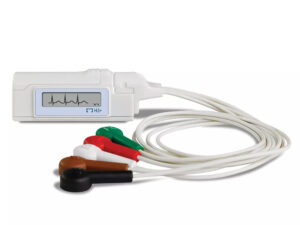 A Holter monitor detects and records heart rate and rhythm continuously throughout the day and night. It is usually worn over a 24 hour period but may be worn up to 48 hours, depending on what has been requested by the referring doctor. Should you be required to wear the monitor for longer than 24 hours you will be provided with a detailed instruction sheet as you will need to re-attach the monitor daily.
A Holter monitor detects and records heart rate and rhythm continuously throughout the day and night. It is usually worn over a 24 hour period but may be worn up to 48 hours, depending on what has been requested by the referring doctor. Should you be required to wear the monitor for longer than 24 hours you will be provided with a detailed instruction sheet as you will need to re-attach the monitor daily.
Preparation
Please advise us beforehand if you are a night shift worker, to assist in optimal interpretation of the results.
Please bring to your appointment:
- Your referral and Medicare, Pension and /or Health Care cards
- A list of your current medications
In preparation for your test:
- Shower beforehand, as you will not be able to shower or bathe again until the monitor is removed in 24 hours.
- Do not apply any lotions or creams to the chest region.
- Wear a two piece outfit if possible to allow easy access to the chest region.
- You will need to return the following day to have the monitor removed.
What happens during the test
- You will be connected to a small heart monitor (no larger than a mobile phone) by 4 electrodes stuck to your chest.
- A technician will clean your chest with alcohol in the areas where the electrodes are attached. ECG leads are attached to stick-on electrodes which are placed around the front of the chest. The electrodes stick to the skin with a gel. Sometimes, an electrode and lead wire will be taped to your chest to prevent them from moving.
- The adhesive electrodes have tape placed over the top to ensure they remain in place. It is important to check that the electrodes are in place throughout the day.
- Should you have an allergy to adhesive tapes please advise the technician fitting the monitor.
- The technician may also have to shave small sections of hair from your chest to ensure sufficient contact of the electrodes with the skin.
- The monitor is worn in a pouch around your neck or in a case at your waist for 24 hours where it records your heart rate and rhythm.
- You may return home or to work and resume most of your usual activities while wearing the monitor, however:
- You must not get the monitor wet, so avoid swimming or showering.
- Electric blankets and magnetic underlays also interfere with the Holter measurements, so they must be avoided for the duration of the test.
- You will be asked to keep a diary of your activity and any symptoms that you experience whilst wearing the monitor (palpitations, dizziness or lightheadedness).
- During the recording you will need to list your symptoms, the time they occur and what you were doing at the time on the diary sheet provided.
- Your doctor can look at the recording around the time of your reported symptoms. This information can help clarify the presence and nature of some particular heart problems.
How long does it take
It takes approximately 20 minutes to fit the monitor, however the monitor is then worn for 24-48 hours.
After the examination
- You will return the following day to have the monitor removed. Do not forget to remove the electrodes taped to your chest.
- You may then resume your normal activities.
- You can disconnect the monitor yourself. The technician will demonstrate how to do so at the time the monitor is fitted.
- The monitor, electrical leads and diary sheet will need to be placed in the envelope provided and returned to Magnolia Specialist Centre at a pre-arranged time.
- It is important to return the monitor at this time as the data must be downloaded and the monitor prepared for the next patient.
Your images and report
A report will be sent to your referring doctor. It is very important you return to your doctor to discuss your results.
Magnolia Specialist Centre will store an electronic copy of your holter trace in our secure database for comparison with any future studies.
This content is intended for informational purposes only. It is not a substitute for professional medical advice. If you require any clarification, please contact your clinician for further information.